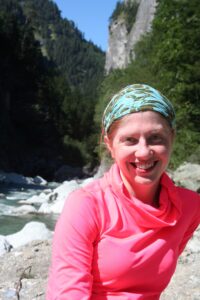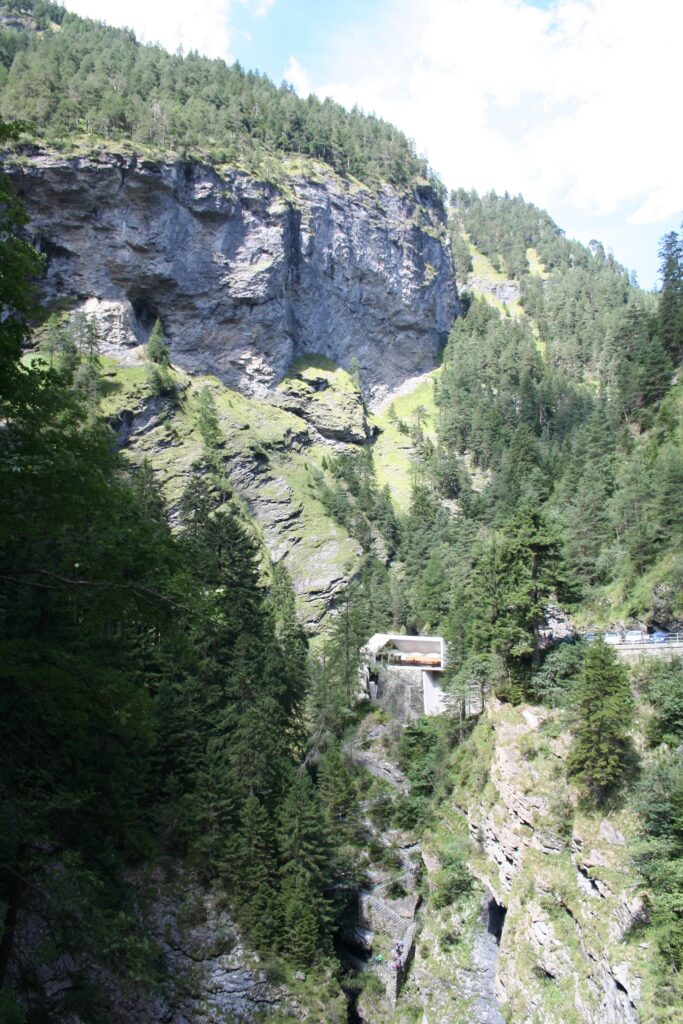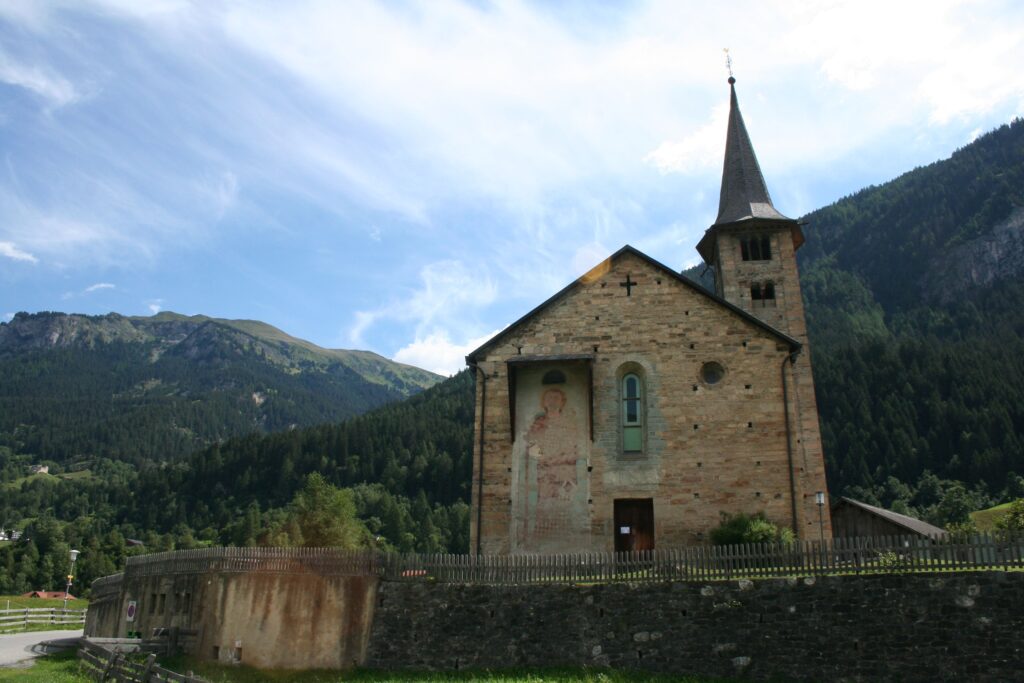This post is part of our ‘mountain research spotlights’ series, sharing the work and insights of colleagues working on mountains across the humanities (and beyond).

Name and Institution: Joanne Anderson, University of Aberdeen.
Research summary: In broad terms, I study the interaction of the visual culture and experiential dimension of mountain environments in the late medieval period, with a specific focus on the European Alps. My research centres the cult of saints in mountain parishes and the use of imagery to connect communities and reflect their concerns across substantial terrain along transit routes. This work enfolds workshop practice and circulation systems that provide insight into the practical matters of artistic practice but also to explore more theoretical questions about the durational quality of art in remote localities. I guess it’s an anti-accelerationism stance since moving through mountain terrain has its own constraints – I’ve co-opted the term ‘slow art’ in recognition of the environmental shaping of art. These research priorities emerged from my enduring specialism in the visual representations of Mary Magdalen, specifically in the Alps, which involves understanding the wider spatial and temporal aspects of her persistent image. Her devotional cult in the late medieval mountains can be correlated with notions of divine ascent, and in doing so link remote and little-known churches and pilgrimage sites to the major centres of Western Christianity.
Do you define yourself as working within the mountain humanities / mountain studies?
Yes, I would say that a good share of my research falls squarely within this domain due to geographic focus and critical enquiry (I also research 20th-century exhibition history). But it also intersects with parish studies, visual culture and performance studies and theology, as well as gender and material culture studies – it’s inherently interdisciplinary. To be clear, Mary Magdalen took me to the mountains, and it was the proliferation of her cult in this expansive terrain that struck me as significant and overlooked. One thing’s for sure, mountains are living environments for my late medieval materials and negotiated as such during field research. They’re also spiritually charged sites that have historically fostered connections to the sacred and the sublime.
Tell us more about the link between field research and writing about late medieval art?

I recently published an essay titled ‘Arming the Alps through Art: Saints, knights, and bandits on the early modern roads’ in the interdisciplinary volume, Travel and Conflict in the Early Modern World, edited by Gabor Gelleri and Rachel Willie (Routledge, 2021).
The essay examines the visual culture of the early modern roads, focusing on the Via Mala or ‘Bad Way’ in the Rhaetian Alps. It explores the challenges of travelling in this period, be it climate, terrain or human, and the deployment of ‘art’ in the landscape as means to mediating a culture of itinerant violence and threat. It considers the experiential dimension of external wall paintings for the mobile eye and body and how sacred archetypes such as St Christopher and St George provided routine surveillance on either side of the treacherous transit route. For example, St Christopher was prayed to for his talismanic protection by travellers and depictions of the saint are distinguished by particular and repetitive formal qualities that enhance his scopic function – pronounced verticality and large eyes to ensure he sees and can be seen from afar!
My own journey along the Via Mala (now a popular tourist destination), navigating its physical demands and observing historical change, was integral to the writing of the essay. I remember receiving the commissioning email whilst in the region on holiday and immediately conceptualising the case study locale and my approach. The essay, which developed out of my book on Mary Magdalen in the Alps, foregrounds new research on the experiential dimension of art in the mountain landscape and how it points us to a different speed of production and consumption.

Is there anything else we should know about your work?
My 2019 book, Moving with the Magdalen: Late Medieval Art and Devotion in the Alps focuses on the imagery of Mary Magdalen that was commissioned, produced and viewed by diverse parish communities in the Maritime, Swiss and Tyrolean Alps. There are a lot – she was popular! Most of them are mural cycles that set out the biblical and apocryphal lives of the saint in increasingly lengthy arrangements, but the book also investigates the impact of altarpieces, manuscripts, stained glass and lost textile banners that stand as indexical markers of devotion. This includes miners in South Tyrol who had a direct and extractive relationship with the numinous mountain environment. Essentially, I wanted to position the Alps as a networked landscape through the prevalence of autochthonous iconography via these devotional works, adapting the ideas and approaches explored in Benedict Anderson’s Imagined Communities (1983) and Enrico Castelnuovo’s seminal scholarship on the Alps and Kunstlandschaft (1970s). I argue that the cult of Mary Magdalen and its visual expression had a unifying effect in the mountains, and this counters the historical trope of bridge or barrier that is often applied to the Alps; a place to pass through and a division between north and south rather than one of residence and industry with its own distinctive cultures. Mary Magdalen’s cult was alive and kicking along primary, secondary and tertiary routes and an understanding of this network and the individual nodal points helps us to appreciate a larger and more connected religious geography.
As with all subjects, you find your people, your networks and new initiatives emerge. When I was still at the Warburg Institute in London, I was invited to organise a conference with Dr Carla Benzan, who’s also part of this Mountain Humanities initiative. She was then a research fellow at the Institute. We had a mutual interest in religious art in the Alps and its experiential dimension, Carla’s being focused on the Sacre Monte of Varallo. We came up with ‘Image and Ascent: Mountain Terrains in the History of Art’ with a call for papers in 2019. Despite job changes for us both (me to the University of Aberdeen and Carla to the Open University) and covid restrictions, the conference went ahead in the form of a four-day online event in September 2020 with keynotes by Jason König and Christopher P. Heuer, and papers from the brilliant Jonathan Pitches and Jonathan Westaway amongst all the other highlights. These sessions set out to bring the upsurge in mountain research into dialogue with the history of images. It fortunately brought us in to contact with Jason and Dawn’s Leverhulme funded project and this network of scholars which is now advocating for a distinct place for mountains in the humanities.
